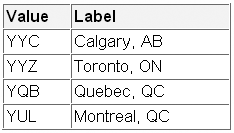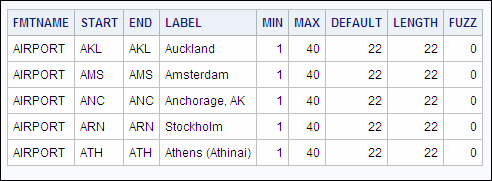Creating SAS Data Sets from Custom Formats
Overview
You
know how to create a format from a SAS data set, but what if you want
to create a SAS data set from a format? To do this, you use the CNTLOUT=
option.
|
General form, CNTLOUT=
option in PROC FORMAT:
PROC FORMAT LIBRARY=libref.catalog CNTLOUT=SAS-data-set;
SELECT format-name
format-name...;
EXCLUDE format-name
format-name...;
RUN;
libref.catalog
is the name of the
catalog in which the format is located.
SAS-data-set
is the name of the
SAS data set that you want to create.
format-name
is the name of the
format that you want to select or exclude.
|
The output control data set will
contain variables that completely describe all aspects of each format,
including optional settings. The output data set contains one observation
per range per format in the specified catalog. You can use either
the SELECT or EXCLUDE statement to include specific formats in the
data set.
Creating
a SAS data set from a format is very useful when you need to modify
a format but no longer have the SAS data set you used to create the
format. When you need to update a format, you take the following actions:
Example
Step 1: Create a SAS Data Set from the Format
First,
you write the $AIRPORT. format as a SAS data set. In the code below,
the output data set is named Sasuser.Fmtdata. The SELECT statement
is used so that the resulting data set has only the data for the $AIRPORT.
format. Without the SELECT statement, the data would have observations
for all the formats in the Sasuser.Formats catalog.
proc format lib=sasuser cntlout=sasuser.fmtdata; select $airport; run;
When you use the CNTLOUT=
option, SAS creates an output data set that has many variables for
storing information about the format. The output data set Sasuser.Fmtdata
has 50 rows and 21 columns. In the PRINT procedure below, the VAR
statement specifies that only a few of the variables are printed:
proc print data=sasuser.fmtdata (obs=5) noobs;
var fmtname start end label min max
default length fuzz;
run;As you can see, the
data set contains End and other variables that were not in the original
data. When you use the CNTLIN= option, if there is no End variable
in the data set, SAS assumes that the Start and End variables have
the same value. When you write the format as a data set using the
CNTLOUT= option, both variables are in the data set.
Step 2: Edit the Data Set
The
next step in updating the format is to edit the data set. You could
use PROC SQL or a DATA step to add observations to the data set, or
you could add observations using the VIEWTABLE window. Whatever method
you choose, you must add values for the FmtName, Start, End, and Label
variables. If Start and End are both present, you must enter values
for both variables. Otherwise, SAS will return an error. You do not
have to add values for the other variables in the data set.
Step 3: Create a Format from the SAS Data Set
Once the data set is
edited and saved, you can create a format from the data set using
the CNTLIN= option. The following code creates the $AIRPORT. format
and then uses FMTLIB to document it:
proc format library=sasuser cntlin=sasuser.fmtdata;
run;
proc format lib=sasuser fmtlib;
select $airport;
run;The
partial output shown below includes the new airports in the format.
|
FORMAT NAME : $AIRPORT
LENGTH: 22 NUMBER OF VALUES: 56 MIN LENGTH: 1 MAX LENGTH: 40 DEFAULT
LENGTH: 22 FUZZ: 0
|
||
|---|---|---|
|
START
|
END
|
LABEL (CONT'D)
|
|
SYD
|
END
|
Sydney, New South Wales
|
|
VIE
|
VIE
|
Wien (Vienna)
|
|
WLG
|
WLG
|
Wellington
|
|
YQB
|
YQB
|
Quebec, QC
|
|
YUL
|
YUL
|
Montreal, QC
|
|
YYC
|
YYC
|
Calgary, AB
|
|
YYZ
|
YYZ
|
Toronto, ON
|
Tip
For more information about
using the CNTLOUT= option, see the SAS documentation for the FORMAT
procedure.
..................Content has been hidden....................
You can't read the all page of ebook, please click here login for view all page.


